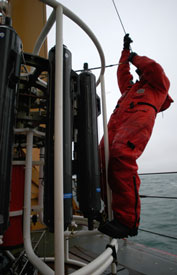 |
Daily Update
Calendar
Dispatch 22 - October 1, 2003
By C. A. Linder
Weather conditions: Overcast skies, snow flurries, 35 kt
winds gusting to 40 kts, 5-7 ft seas, air temperature 31°F
Mother Nature
I'm going to stop making predictions about the next day's plans.
After yesterday's nice calm weather, I assumed that the mooring
would be a definite go for today. Today was another reminder of
just how savage arctic storms can be, and how fast they can close
in. By the time I woke up, gale force (35+ knot) winds were building
the sea into towering swells. Big snowflakes swirled around the
ship, collecting on the mooring equipment on the fantail. The wind
raged unabated all day, forcing us to cancel the mooring deployments.
The ship even started rolling in the swells at lunchtime, a strange
sensation after so many days of relatively calm seas. Marine Science
Technician Senior Chief and weather guru Glen Hendrickson warned
us that "the weather may be worsening overnight before it improves."
Here are some questions from Mrs. Cadwell's
class at Varnum Brook Elementary School.
Question from Shawn: Do you eat copepods?
Answer: Hi Shawn. No, I haven't tried a copepod and I don't think anybody else eats them either. I checked with Carin Ashjian just to make sure, and she told me: "copepods are very tiny, and the chitinous exoskeleton (like a grasshopper) would be difficult for humans to digest. However, humans do eat their larger relative, the shrimp."
 |
 |
| Marine Science Technician Daniel Gaona keeps the wire taut on the CTD while the winch takes up the slack. |
| Click
to enlarge |
Question from Shannyn: How much and what type of
fuel does the Healy run on? If you have a power outage,
what is your back up?
Answer: Shannyn, the Healy runs on diesel fuel
and has a capacity of 1,221,000 gallons. That's 81,400 fill-ups
at the gas station for a typical car! Assuming typical gas consumption
for a typical car, that amount of gas would last you 108 years!
The Healy has many redundant backups which keep the power
running smoothly. The first backup is a completely redundant generator.
Healy has four massive electrical generators that produce
11.2 Megawatts of power, but can only use three at one time. That
leaves one spare for backup purposes. If the main generators fail,
there is an emergency generator capable of producing 2.2 Megawatts
of power, and also a small Honda generator. So far we haven't had
any power outages on the cruise.
Question from Grace: What does an expedition like this cost?
Answer: Hi Grace, good question! A project of this size is obviously incredibly expensive... There are so many different things that must be paid for - the cost of operating the ship, shipping the instruments, salaries of the science party, plane tickets to Alaska, and of course the mooring equipment itself. While I don't know the exact figure for how much the expedition costs in total, one of the most expensive things is ship time. The cost of operating the Healy is over $20,000 each day. For this cruise, that means almost a million dollars for just the ship use! That's one of the reasons why weather delays can be so disappointing.
We can only hope that Mother Nature gives us a
break tomorrow! The mooring instruments are prepared and ready to deploy. It's frustrating having to wait to begin the deployment, but weather delays are all part of the job.
 Previous
Dispatch
Next Dispatch Previous
Dispatch
Next Dispatch

Back to
Calendar
|




